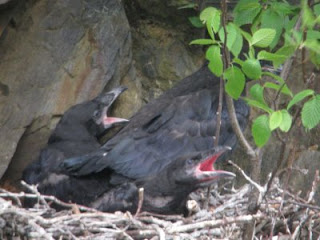 A little over a week ago while making a house call on an acquaintence in south central Vermont I was greeted by a turkey after getting out of my vehicle. The bird approached much as any barnyard bird might and at first I discounted it as a domestic bronze variety. It was very inquisitive and literally came to my side making "putt putt" vocalizations, cocking its head to the side and giving me a upward glance. It then became obviously apparent that this bird bore all the plumage characteristics of a young wild bird. Now, I have observed a wild turkey now and again that displayed somewhat fearless behavior but nothing so extreme as this individual. Willing to push my luck I reached down and was surprised at being permitted to place my hand on its hard-as-armor feathered back, although at a cost of a very sturdy peck at my hand and a resulting blood blister. This was indeed a first of a kind encounter. Fetching my camera out of the car, I clicked off several close-ups as this opportunity was no doubt very much out of the ordinary.
A little over a week ago while making a house call on an acquaintence in south central Vermont I was greeted by a turkey after getting out of my vehicle. The bird approached much as any barnyard bird might and at first I discounted it as a domestic bronze variety. It was very inquisitive and literally came to my side making "putt putt" vocalizations, cocking its head to the side and giving me a upward glance. It then became obviously apparent that this bird bore all the plumage characteristics of a young wild bird. Now, I have observed a wild turkey now and again that displayed somewhat fearless behavior but nothing so extreme as this individual. Willing to push my luck I reached down and was surprised at being permitted to place my hand on its hard-as-armor feathered back, although at a cost of a very sturdy peck at my hand and a resulting blood blister. This was indeed a first of a kind encounter. Fetching my camera out of the car, I clicked off several close-ups as this opportunity was no doubt very much out of the ordinary.I was soon joined by Forrest, the resident, who told me how this bird came to take up residence there. Taylor, the name given to it by Forrest's grandson, was orphaned after its mother was hit by a car. Leaving two young poults behind, Forrest collected them and brought home for care. One of the poults died shortly after, but Taylor perservered and thrived on a steady diet of worms and insects. Eventually it was capable of fending for itself, and Forrest fully expected that it would wander off to join one of the marauding flocks of wild turkeys that periodically passes through the surrounding woodlands. While Taylor communicates with its wilder kindred, it has so far shown no interest in the hard life.
 Lacking fear of humans, Taylor has staked out its own territory around the Forrest homestead following family members about and persistently demanding their attention by tugging on clothing and pecking exposed fingers. Forrest admits Taylor has become somewhat of a nuisance but has yet crossed the threshold of wearing out its welcome. It has also become attached to a very old horse and frequently roosts on its rump using the vantage point to scope out its turf. Frequently the bird will "groom" the horses coat but can be a bit overzealous resulting in a gentle buck from the gelding.
Lacking fear of humans, Taylor has staked out its own territory around the Forrest homestead following family members about and persistently demanding their attention by tugging on clothing and pecking exposed fingers. Forrest admits Taylor has become somewhat of a nuisance but has yet crossed the threshold of wearing out its welcome. It has also become attached to a very old horse and frequently roosts on its rump using the vantage point to scope out its turf. Frequently the bird will "groom" the horses coat but can be a bit overzealous resulting in a gentle buck from the gelding.
 Lacking fear of humans, Taylor has staked out its own territory around the Forrest homestead following family members about and persistently demanding their attention by tugging on clothing and pecking exposed fingers. Forrest admits Taylor has become somewhat of a nuisance but has yet crossed the threshold of wearing out its welcome. It has also become attached to a very old horse and frequently roosts on its rump using the vantage point to scope out its turf. Frequently the bird will "groom" the horses coat but can be a bit overzealous resulting in a gentle buck from the gelding.
Lacking fear of humans, Taylor has staked out its own territory around the Forrest homestead following family members about and persistently demanding their attention by tugging on clothing and pecking exposed fingers. Forrest admits Taylor has become somewhat of a nuisance but has yet crossed the threshold of wearing out its welcome. It has also become attached to a very old horse and frequently roosts on its rump using the vantage point to scope out its turf. Frequently the bird will "groom" the horses coat but can be a bit overzealous resulting in a gentle buck from the gelding.
Forrest has no idea how long Taylor will remain, but suspects that once spring approaches and its hormones kick in for mating it will find its proper ecological niche. In the mean time it has managed to allude predators and is providing the Forrest family with a rare but intimate opportunity to observe and appreciate a wild turkey up close and personal despite Taylor's less than typical wild turkey behavior.
The resurgence of wild turkeys in Vermont is a wildlife restoration success story. The state's last turkeys were extirpated by 1854 as a consequence of habitat distruction and uncontrolled hunting. In late 1960s the Vermont Fish and Wildlife Department undertook an effort of reintroducing turkeys to the state from wild stock obtained from New York. The original releases occurred in 1969 and 1970 of 17 birds introduced in Pawlet and 14 birds in Hubbardton, respectively. From these few birds the state's population grew rapidly to an estimated 600 birds by 1973. In-state relocations further encouraged the population to grow and broaden its distribution. The population is currently estimated at 35,000 birds distributed statewide and supports well regulated hunting. Turkeys are so abundant now that they are a common sight around many suburban backyard bird feeders and if they become too frequent visitors can bust the feed budget. This unlikely affinity for humans perhaps offers some insight in the domestication of the species by the Mesoamerican Aztecs prior to arrival of Spanish conquistadors.
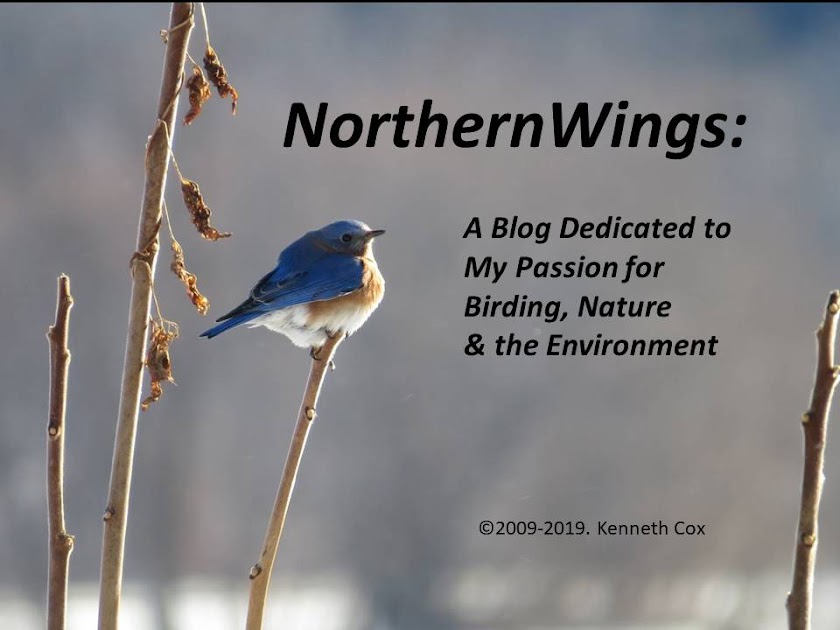
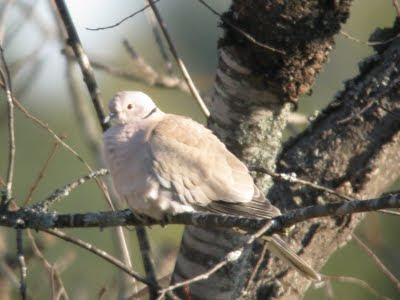







 This past Tuesday I participated in a nine hour pelagic birding trip off the New Hampshire coast organized by the Massabesic Audubon Center. It was likely the last pelagic outing I will take in this year, and if that proves to be the case, for myself I cannot possibly imagine this trip being outdone anytime soon. Simply stated last Tuesday was fantastic! The weather and sea conditions were near perfect, and the seabirds and other marine life presented an exciting spectacle.
This past Tuesday I participated in a nine hour pelagic birding trip off the New Hampshire coast organized by the Massabesic Audubon Center. It was likely the last pelagic outing I will take in this year, and if that proves to be the case, for myself I cannot possibly imagine this trip being outdone anytime soon. Simply stated last Tuesday was fantastic! The weather and sea conditions were near perfect, and the seabirds and other marine life presented an exciting spectacle.

 Later in the day Steve, Jane, Len, Lance and I took in the whale watch trip hoping for some good pelagic bird activity and for me getting first-time views of Red-necked Phalarope and Manx Shearwater, both reported seen offshore by others earlier this week. The leg between Rye Harbor and the Isles of Shoals was fairly void of pelagics, but once past the Isles actitivy steadily increased. Winds were from the SSE, skies clear and sunny. The following more notable counts of our observations were tallied by Steve: Cory's Shearwater, 9; Greater Shearwater, 628; Sooty Shearwater, 309; Manx Shearwater, 4; Wilson's Storm-Petrel, 330; Northern Gannet, 6; Red-necked Phalarope, 7; phalarope sp., 12; Common Tern, 45; and jaeger sp., 1. For most of the passengers, anticipation was focused on whales, and they (as we) were not disappointed. A total of 8 Humpback Whales were seen at close range bubble feeding and tail breaching. Surface feeding behavior was a cue to shearwaters in the area that leftover food was present. This was a great asset to me in identifying my first Manx Shearwater after missing the three previous birds sighted that afternoon. The fourth Manx of the day passed just ahead of the boat bow gliding to the shearwater feeding frenzy. Photos below: Top - Greater Shearwater; Bottom - Greater and Sooty Shearwaters cleaning up the spoils following a Humpback Whale feed.
Later in the day Steve, Jane, Len, Lance and I took in the whale watch trip hoping for some good pelagic bird activity and for me getting first-time views of Red-necked Phalarope and Manx Shearwater, both reported seen offshore by others earlier this week. The leg between Rye Harbor and the Isles of Shoals was fairly void of pelagics, but once past the Isles actitivy steadily increased. Winds were from the SSE, skies clear and sunny. The following more notable counts of our observations were tallied by Steve: Cory's Shearwater, 9; Greater Shearwater, 628; Sooty Shearwater, 309; Manx Shearwater, 4; Wilson's Storm-Petrel, 330; Northern Gannet, 6; Red-necked Phalarope, 7; phalarope sp., 12; Common Tern, 45; and jaeger sp., 1. For most of the passengers, anticipation was focused on whales, and they (as we) were not disappointed. A total of 8 Humpback Whales were seen at close range bubble feeding and tail breaching. Surface feeding behavior was a cue to shearwaters in the area that leftover food was present. This was a great asset to me in identifying my first Manx Shearwater after missing the three previous birds sighted that afternoon. The fourth Manx of the day passed just ahead of the boat bow gliding to the shearwater feeding frenzy. Photos below: Top - Greater Shearwater; Bottom - Greater and Sooty Shearwaters cleaning up the spoils following a Humpback Whale feed. 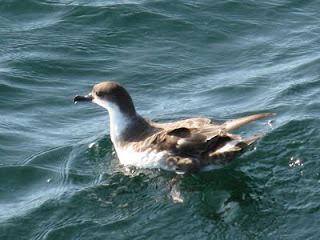


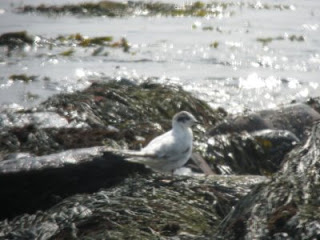
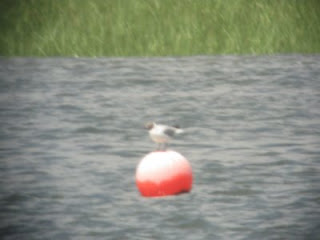









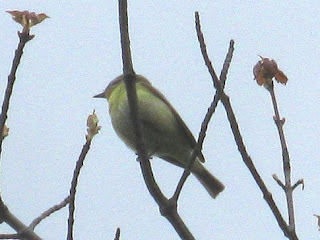.jpg)
.jpg)

